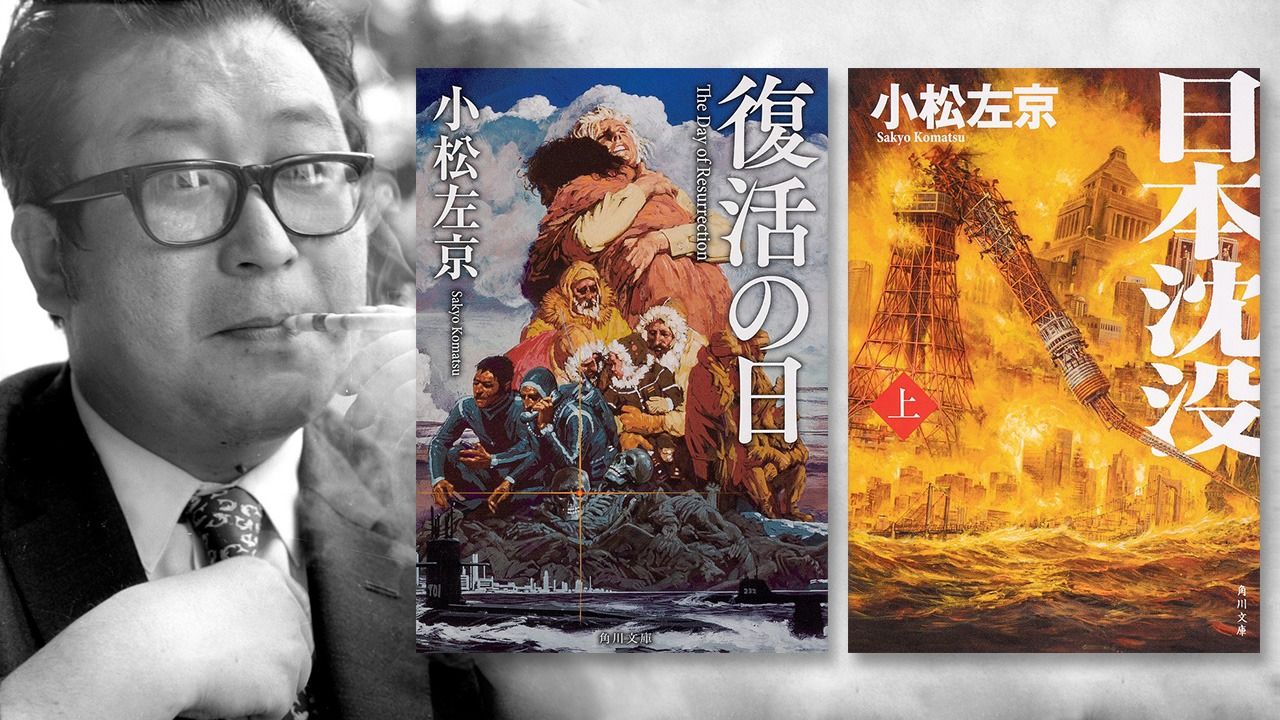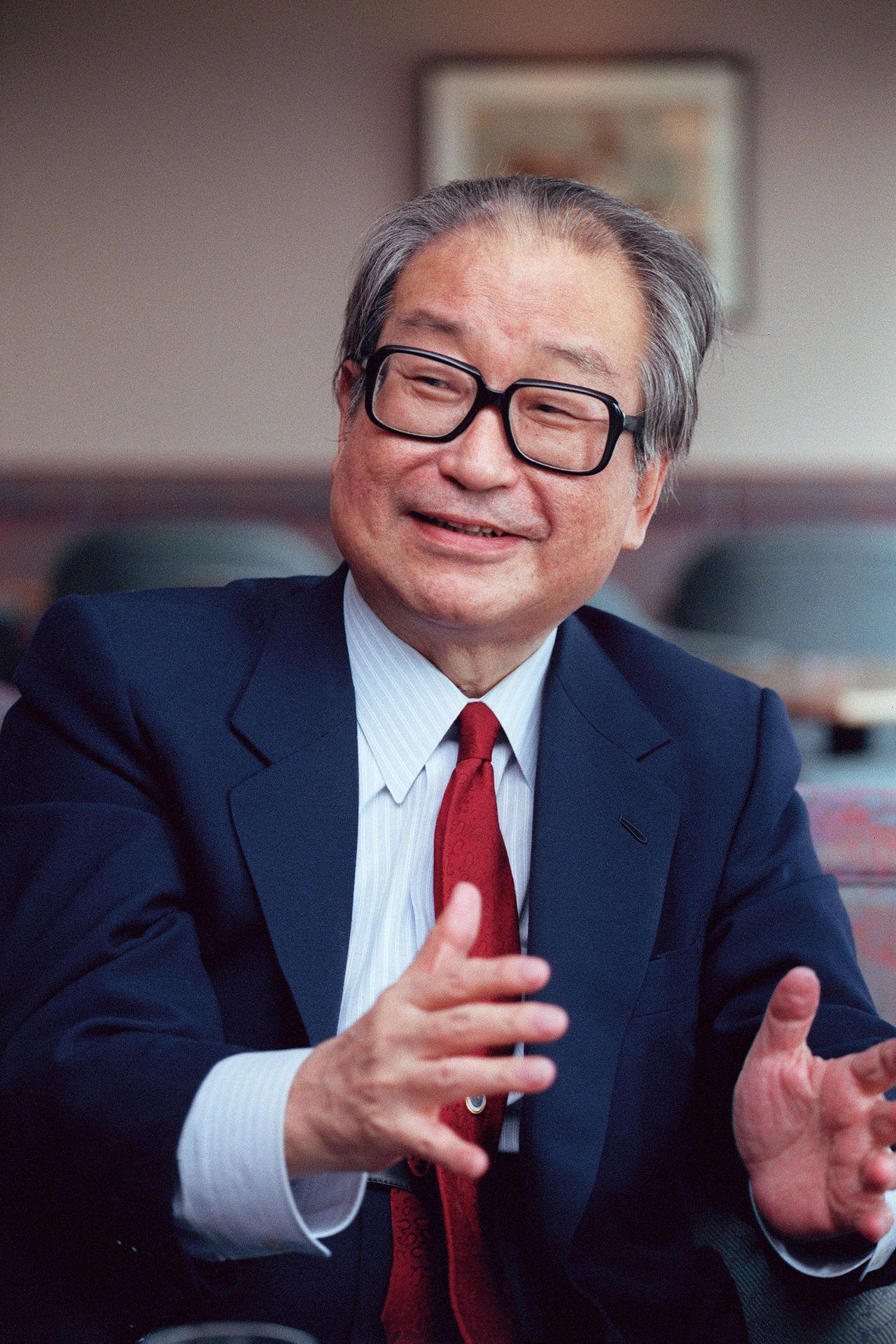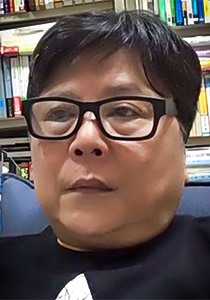
Komatsu Sakyō: Japan’s Apocalyptic Sci-Fi Author in the Spotlight in 2020
Society Culture Books- English
- 日本語
- 简体字
- 繁體字
- Français
- Español
- العربية
- Русский
Authentic Tension
The COVID-19 outbreak this year prompted a revival in Japan of science-fiction author Komatsu Sakyō’s 1964 novel of disease run rampant, Fukkatsu no hi (trans. Virus: Day of Resurrection). Meanwhile, the hit Netflix animation Japan Sinks: 2020 is another reason Komatsu is now in the spotlight. It is an updated adaptation of his Nihon chinbotsu (trans. Japan Sinks), which became a publishing phenomenon after its 1973 release.
Virus: Day of Resurrection was Komatsu’s second novel. Set at the height of the Cold War in an unspecified year in the 1960s, it tells the story of how a biological weapon—a new kind of deadly virus, called MM-88, developed from an extraterrestrial organism—is released and brings humanity to the brink of extinction. The only survivors are around 10,000 people at Antarctic research stations and the crews of two nuclear submarines, one from the United States and one from the Soviet Union. Meanwhile, the 4.6 million bestseller Japan Sinks imagines a series of huge earthquakes leading to the country dropping beneath the waves, so that the Japanese become a people without a nation.
Another Komatsu work to draw interest recently is the 1977 short story “Amerika no kabe” (America’s Wall). In the story, the United States is tending toward isolationism when one July 4, the nation is cut off from the world by a mysterious, white cloud-wall. Numerous online discussions in recent years have drawn parallels with America under the Donald Trump administration. Along similar lines, in Komatsu’s 1985 novel Shuto shōshitsu (Vanished Capital), Tokyo is covered by a giant sea of clouds that prevent access to the outside world, which made many recent readers in Japan think of the pandemic state of lockdown.
“I think that a lot of people talked about Japan Sinks after the 1995 Great Hanshin-Awaji Earthquake and the 2011 Great East Japan Earthquake too, so Komatsu’s works have become topical at various times in the past,” comments science fiction translator Ōmori Nozomi. “While the plate tectonic theory in Japan Sinks and MM-88 in Virus: Day of Resurrection apply the scientific knowledge of the time, the events could not actually have taken place. Nonetheless, they convey a sense of reality to the reader, even fifty years after publication. This is because the writer’s skill at composition, including the way he incorporates information in the story, cultivates an authentic tension. While his books are based on the situation at the time of writing, readers see their own contemporary situation in what takes place, and feel that they’re prophetic. That’s the great thing about Komatsu’s fiction.”
A Life-Changing Publication

Komatsu Sakyō, born in Osaka in 1931, made his debut in SF Magazine in 1962. According to his 2006 autobiography, at that time he had written 17 novels. He died in July 2011 at the age of 80. Photo taken in 1992. (© Jiji)
Komatsu is seen as one of Japan’s three great SF pioneers, alongside Hoshi Shin’ichi and Tsutsui Yasutaka. His debut in the genre was sparked by the publication of the first edition of SF Magazine by Hayakawa Publishing in 1959.
“There were almost no Japanese SF writers then,” Ōmori says. “At first, SF Magazine was for translations of short stories written in English. In 1960, the magazine started a contest for new writers, opening the path for Japan’s first generation of SF authors, including Komatsu, Mayumura Taku, Hanmura Ryō, and Tsutsui Yasutaka.”
Komatsu started out writing literary fiction, having specialized in Italian literature at Kyoto University, and become involved in self-publishing of magazines. “He wrote serious literary short stories in the magazines, but he must have felt it didn’t suit him,” Ōmori notes. “Then he came across the first edition of SF Magazine, and it instantly opened up his world. Reading avidly through the foreign fiction it published, he thought to himself, ‘this is what I’ve been looking for’ and got writing as soon as he heard about the contest.”
Ōmori describes Komatsu’s sci-fi debut. “The story he submitted was ‘Chi ni wa heiwa o’ (Peace on Earth), depicting a parallel world in which World War II was still ongoing. It only won an honorable mention—although it was later nominated for the Naoki Prize—but Komatsu worked hard from there to write more fiction, and became a major figure in the science fiction world.”
War Experience as Science Fiction
Komatsu’s war experience was the foundation for much of his writing. “Peace on Earth” came from his wish to write about the conflict. In his autobiography, he gave this explanation. “I thought for a long time that I had to write about the war that had taken the lives of even young boys and girls of my generation. But when the memory was still raw, I couldn’t put it down on paper. I didn’t know in what way to write about it either. It would become this huge, oppressive story. But then I thought, what if I changed the history . . .” Discovering the genre of science fiction gave him a way of depicting the war.
Born in Osaka, Komatsu was 10 years old when Japan opened another front of the conflict through its attack on Pearl Harbor in 1941. He lived through air raids and military drills before the war ended when he was 14. While Emperor Shōwa gave his historic radio broadcast announcing Japan’s surrender, Komatsu was listening in the factory where he had been deployed as a student worker. In the immediate postwar period, he also worked for a time clearing up the charred corpses of people who had died in air raids. He long felt that if the war had continued, he would likely have been called up and died in his turn. “If there had been no war, I probably wouldn’t have become an SF writer,” he said.
Ōmori comments, “Japanese science fiction took off along with the country’s high-growth period, but at the start of the 1960s, there were still strong reminders of the war here and there. Komatsu’s first novel, the 1964 Nihon Apacchi-zoku [The Japanese Apache], was inspired by the postwar black markets that emerged across the devastated nation. He also wrote several SF short stories directly on the topic of war.”
Zooming Out
Komatsu’s science fiction, inspired by his wartime experience, is characterized by what Ōmori calls its macroscopic viewpoint. “It encompasses the history of humanity, the earth, and the universe. How we should think about history and civilization are major themes, and he depicts Japan’s place within that. Particularly in Japan Sinks, he asks what gives Japanese people their identity if the country itself is gone.”
For Komatsu, when presenting his views of history and civilization and commenting on Japan’s place in the world, science fiction was ideal as a genre that made it possible to write on a grand scale when compared with ordinary novels.
“Of Japan’s big three SF writers, while Hoshi specialized in short-short stories and Tsutsui wrote freely, unhindered by genre boundaries, Komatsu took the classic, main road of hard science fiction. People argue about how to define hard SF, but one important aspect is that it’s based on scientific knowledge and particularly focused on accomplishments in the natural sciences. Komatsu let his imagination loose on what were then the latest findings in geoscience like plate tectonics and mantle convection, as well as cutting-edge advances in biochemistry and computer science. Taking the latest science and seeing what outrageous ideas it inspires is what makes hard SF so much fun.”
Incidentally, Ōmori suggests that Komatsu’s most important book is the 1965 Hateshi naki nagare no hate ni (At the End of an Endless Stream), in which the protagonist becomes embroiled in a battle across time and space, traveling on a journey of escape for 1 billion years. “It takes in the whole sweep of human civilization from beginning to end. While it has some flaws as a novel, it’s the book that best conveys the power of Komatsu’s science fiction.”
Influence on The Three-Body Problem
Michael Crichton’s The Andromeda Strain is another book receiving fresh attention during the pandemic. It was published in the United States in 1969, and Komatsu himself jokingly suggested it had taken some hints from Virus: Day of Resurrection. “It’s true that there was an outline of Komatsu’s book prepared for a possible film adaptation at 20th Century Fox, and it wouldn’t be at all strange if Crichton had seen it,” Ōmori notes. “But while the premise was similar, the two works went in completely different directions. Virus: Day of Resurrection was on a huge scale, concerning the near extinction of humanity. By contrast, The Andromeda Strain is written in a nonfictional style, following scientists struggling to contain a harmful, unknown microorganism that has fallen to earth, carried by a satellite.”
The English translation of Virus: Day of Resurrection by Daniel Huddleston was published in 2012. Komatsu’s domestic blockbuster Japan Sinks had previously appeared in English in 1976 and was translated into many other languages, but it failed to become a global hit. “This was the 1970s, when almost no long-form Japanese science fiction was being translated, and while Japan Sinks was published in English, it had been cut to about half its length and nobody paid it much attention,” Ōmori says. “If there had been a proper translation, it might have become a hit like The Three-Body Problem.”
The Chinese SF trilogy of alien invasion, commonly known as The Three-Body Problem, from the title of its first book, has sold more than 1 million copies in the United States and 29 million worldwide. Author Liu Cixin was influenced by Komatsu’s Japan Sinks.
“The Cultural Revolution was happening in China when Japan Sinks was published,” notes Ōmori. “There were very few foreign novels being translated, but Chinese versions of Japan Sinks and some of Arthur C. Clarke’s novels appeared unusually quickly. Liu read them as a student, and apparently took great inspiration. It was only from the 1980s on that a lot of other Japanese and English-language science fiction was translated and published in China.”
Ōmori is the leader of the team translating The Three Body Problem into Japanese; the first two books have been published. He says he feels a strong influence from Clarke in the first book, Isaac Asimov in the second, and Komatsu throughout. “One of the major themes is what would happen if the earth was destroyed, so it could be seen as a version of Japan Sinks for all humanity. The way it takes a macroscopic view, looking down over human history and the Milky Way, at the same time that it pays attention to realistically conveying some very human moments among its ordinary characters, makes me think of Sakyō. Particularly in the third book, there are scenes everywhere reminiscent of Japan Sinks.”
SF and Society
Komatsu was said to be like “a computer-equipped bulldozer” for his considerable activity in the science fiction world, but he also had a wide network. His interactions with the anthropologist Umesao Tadao and the sociologist Katō Hidetoshi, as well as other Kyoto University academics, played their part in his formation of the structure of Japan Sinks. Through Umesao, he became involved in the organization of the 1970 Osaka Expo.
“As well as an author, Komatsu was a producer,” Ōmori says. “Besides the Expo in 1970, he led the organization of an international SF symposium, dashing about energetically to find companies and others to sponsor it. Arthur C. Clarke and other SF authors from both the Western and Eastern blocs gathered for the first time in one place for a groundbreaking conference.”
Ōmori says that there will never be another writer like Komatsu: full of vigor, influential, and an enthusiastic member of the wider society.
“I think Komatsu in particular, and the rest of Japanese science fiction’s first generation, thought about what the genre could do, and its social role. My impression is that science fiction has become out of step with reality since the 1990s. While a lot of SF anime and films are being made, SF novels have become a special kind of genre with no connection to the world. In the last few years or so, however, I’ve seen some signs of change. The fact that The Three-Body Problem became an international bestseller has brought renewed appreciation of science fiction’s strengths. In July, a program with Japan’s major SF writers talking about the postpandemic world appeared on terrestrial television. It was also on YouTube, and got people talking online, so these SF writers proactively addressing society made a strong impression. Also, Takayama Haneko, who won the Akutagawa Prize this summer, comes from an SF background, and there has been a great leap in interest in science fiction across the publishing world. I’m eager to see how the latest generation of SF writers asserts itself in the years to come.”
(Originally published in Japanese on September 24, 2020. Interview and text by Itakura Kimie of Nippon.com. Banner photo: Komatsu Sakyō [© Kyōdō News Images] next to covers for Fukkatsu no hi [trans. Virus: Day of Resurrection], at left, and Nihon chinbotsu [trans. Japan Sinks], both courtesy Kadokawa Bunko.)
fiction novels author earthquakes coronavirus COVID-19 pandemic
